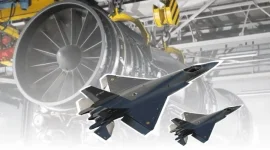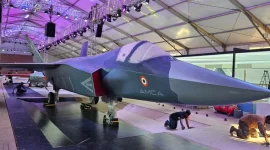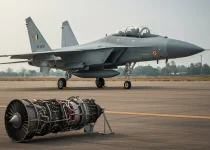- Views: 109
- Replies: 2
A significant portion of India's populace favours international cooperation for acquiring critical defence technologies over the government's emphasis on complete self-reliance (Atmanirbharta), according to a survey released by The Takshashila Institution on April 18, 2025.
The findings highlight a potential disconnect between policy goals and public/industry preferences, particularly concerning the Indian Air Force's (IAF) modernisation and advanced aircraft development.
The survey, conducted amidst ongoing discussions about the IAF's fighter squadron requirements and the indigenous development of the Advanced Medium Combat Aircraft (AMCA), indicates a strong preference for technological partnerships, primarily with the United States (favoured by 45.4% of respondents) and Israel (20.5%).
This inclination surfaces even as the survey points to a concerning trend within India's private defence industry: a tendency to prioritise the assembly of imported components—often termed "screwdriver giri"—rather than investing substantially in original research and development (R&D). This practice could potentially hinder India's long-term strategic objective of achieving self-sufficiency in critical defence manufacturing.
Data for the survey was gathered between November and December 2024, involving 655 individuals representing a cross-section of stakeholders, including private industry leaders, defence personnel, government officials, academics, and policy researchers.
The results, published in the "Pulse of the People: State of India-China Relations" report, arrive as India addresses a notable shortfall in its fighter fleet, currently operating 31 squadrons against an authorised strength of 42.5, and navigates the ambitious timeline for the 5.5-generation AMCA, projected for its first flight by 2029 and service induction around 2035.
Respondents strongly supported international technology collaborations, suggesting that co-developing and co-producing next-generation systems with reliable partners is preferred over relying solely on indigenous projects like the AMCA, spearheaded by the ADA under the DRDO with HAL and private firms.
The perceived urgency to enhance the IAF's capabilities quickly was cited as a key reason, with the survey noting the government faces a choice "between indigenous AMCA and co-development/co-production of next-gen aircraft" to meet immediate defence needs.
When asked about preferred partners, geopolitical ties and technological prowess appeared paramount. The United States led significantly, followed by Israel, France (18.1%), and Russia (12.9%).
Notably, among defence and security personnel, Israel emerged as the top choice (35.2%), likely reflecting successful joint projects like the Barak 8 missile system. The US (31.5%) and Russia (19.4%) were also favoured by this group.
These preferences suggest a practical approach focused on accessing proven, advanced technology rather than a strict adherence to the self-reliance doctrine.
While public opinion leans towards partnerships, the survey critically highlights the private sector's operational preference for assembling products using imported kits and transferred technology.
Although major firms like Tata Advanced Systems, Mahindra Defence, and Larsen & Toubro participate in high-value projects (e.g., the Tata-Airbus C-295 transport aircraft manufacturing), the business model often involves licensed production or assembly with minimal original Indian design input.
This strategy capitalises on India's manufacturing cost advantages for potentially quicker returns but does little to build domestic intellectual property (IP) – a cornerstone of true self-reliance.
This operational focus is underscored by India's relatively low R&D expenditure, which stands at approximately 0.64% of its GDP. This figure lags significantly behind innovation leaders like Israel (around 6.3%) and China (around 2.6%).
Furthermore, government funding constitutes the bulk of this spending, with private sector R&D investment remaining comparatively low, deterred by the long development cycles, inherent risks, and costs associated with cutting-edge research.
An example cited involves the domestically developed Wheeled Armoured Platform (WhAP by DRDO and Tata), which was reportedly passed over in favour of procuring the proven Stryker vehicle from the US, illustrating the preference for established foreign systems.
This trend directly challenges the core principles of Atmanirbharta and the Defence Acquisition Procedure (DAP) 2020, which prioritises the 'Indian-designed, developed, and manufactured' (IDDM) category.
Experts note that IP can represent up to 70% of a modern defence product's value. However, companies often utilise 'Buy (Indian)' categories, collaborating with foreign Original Equipment Manufacturers (OEMs) to assemble goods locally without substantial indigenous R&D. Critics argue this approach disadvantages genuine Indian firms investing heavily in IP creation.
The AMCA project itself embodies the tension between indigenous ambition and practical constraints. While envisioned as a cutting-edge aircraft incorporating stealth and supercruise capabilities (with a budget of Rs 15,000 crore for initial prototypes), its lengthy development schedule and initial reliance on foreign components like engines (potentially GE F414 before an indigenous option is ready post-2035) underscore the difficulties.
The survey's findings suggest a preference among stakeholders for potentially accelerating projects like AMCA through partnerships, perhaps leveraging US or Israeli expertise in specific subsystems.
Ultimately, the survey results question the narrative that complete self-reliance is the sole path forward for India's defence modernisation.
While government initiatives like the Positive Indigenisation Lists (PIL) and Innovations for Defence Excellence (iDEX) aim to boost domestic capabilities, concerns remain about potential impacts on operational readiness if import restrictions or overly ambitious indigenous timelines lead to delays, as highlighted by IAF Vice Chief Air Marshal A.P. Singh's 2024 statement cautioning that self-reliance should not compromise national defence.
Analysts suggest a balanced approach, minimizing foreign dependence strategically rather than attempting to eliminate it entirely, is likely more feasible.
The private sector's focus on assembly over deep R&D is viewed by some as a logical market response, minimising risk and maximising near-term gains. However, this path risks stifling the long-term innovation ecosystem required for India to become a leading defence exporter and technology power.
While recent government measures allocating more funding for domestic procurement (68% of capital budget) and private R&D (25% of defence R&D budget) are positive steps, ensuring that policies effectively incentivise and enforce genuine IDDM contributions will be crucial for achieving India's strategic defence goals.







